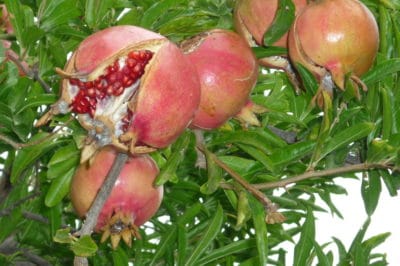Growing Pomegranates
As you might expect, the pomegranate prefers to grow in warm dry areas. Most pomegranates do best in USDA Zones 8 to 10, although a few varieties are hardy to Zone 7. As long as the soil drains well, they are not fussy about their growing conditions. Grow them in full sun. Water about once a week unless the weather is very hot and windy.
Pomegranate Varieties
There are over 500 pomegranate cultivars, although some are available only from specialty growers or grown only in certain countries. Flavors vary from sweet to tart. All must ripen on the tree. These are usually available:
- Angel Red
- Desertnyi
- Early Wonderful
- Granada
- Kashmir Blend
- Parfianka
- Pink Satin
- Sienevyi
- Wonderful.
Pomegranate Season
There are a number of variables that influence the actual season for ripe pomegranates. One, of course, is the weather – a late, cold spring may delay blossoming. Varieties blossom and fruit at different times, but you can usually get an estimate when you buy the plant. Your USDA Zone may also have an impact. Generally speaking, the “season” is from mid-July to October.
Color and Ripeness
You can find pomegranates in several different colors. The rinds of some turn crimson red, while others may be pale pink. Still others might be a creamy white or mottled with yellow even when ripe. A few are a deep reddish purple. However, no matter what the color, a ripe pomegranate should have no trace of green in its rind.
Shape and Ripeness
When pomegranate fruits first develop, they are basically round in shape. As the seed chambers swell, the fruit takes on more of a hexagonal shape and the ends flatten. The large, heavy fruits begin to pull the branches down and the tree may take on a weeping shape. As the fruits become blocky, the rind surface changes from glossy and smooth to matte finish and will feel rough.
Other Signs
If you think your pomegranates are ripe, pull and gently twist one – if it readily slips from the stem, the fruit is ready. For actual harvesting, however, cut with shears. You can also tap the rind with your finger. Ripe pomegranates will have a tinny sound. Eventually, one or more fruits will split. At that point, harvest the entire crop – all should be ripe.
